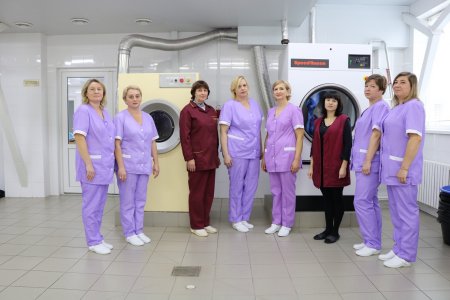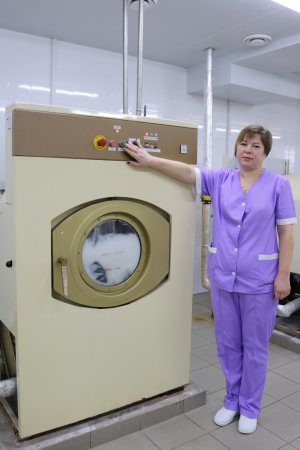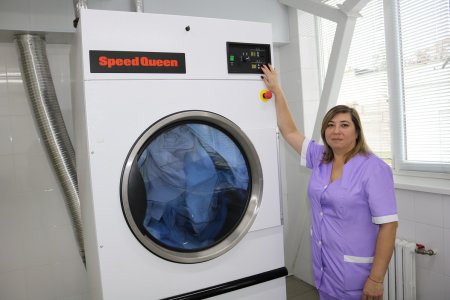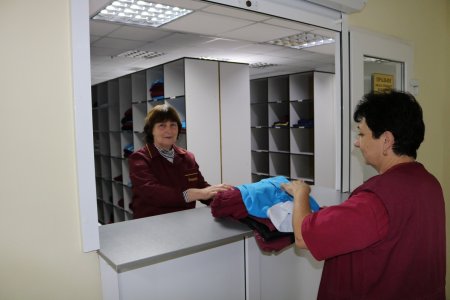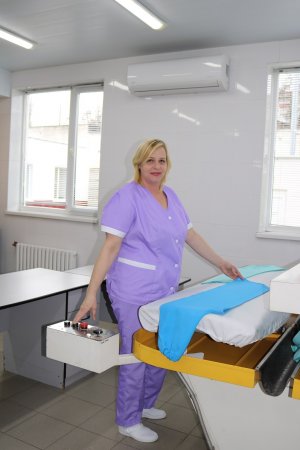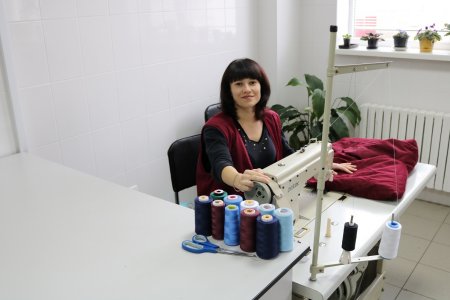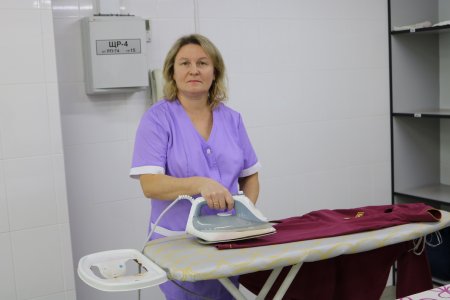Impeccable cleanliness system
It has been long known that if some work direction is done perfectly, we are used to taking it for granted. And often, even for a second, we do not wonder how much work, experience, and talents are used to make the grass look always green, flowers look cultivated, paths look swept, and the working clothes of the huge meat-processing manufacturer look always spotlessly clean. After all, large food industry enterprises have their specificity, which reflects in working clothes variety. Besides, the main component is that production conditions demand constant cleanliness observance.
Olena Matsenko and Liubov Zamikula, plant employees with long-term work experience, told us about forming the clothes washing system at Kremenchukmyaso.
Liubov Zamikula, (27 years of work at the plant, most time worked in the administrative maintenance department (AMD)):
- In Soviet times, a laundry room was situated on the premises, where now we can see the AMD. At those times, there were dark damp semi-basement premises. They had poor lighting and mold. They were equipped with two large machines for 50kg and 100kg. The machines worked with the help of steam. Besides, there were centrifuges for drying, or rather, for spinning laundry, and a big tumble dryer. Employees did not wear various working clothes for different kinds of work, but everyone wore the same white working robe. They used to wash all the clothes without sorting, using Lotos washing powder and very coarse, even black laundry soap. It was grated and put into the washing machines. After such general washing, the working robes became brick-colored. Blood and grease stains did not wash off. The robes just underwent heat treatment, losing their primary look completely.
In 1998 with Kremenchukmyaso setting up, the laundry room was situated on the basement premises under the steam shop. These were spacious rooms with white tiles. Although the premises were large, ceilings were low, there were no windows, and very bad dampness disturbed them greatly. Completely new facilities were bought for the new laundry room. Employees started sorting the clothes, dividing them into cleaner and dirtier clothes. They removed obsolete detergents, replaced them with modern ones, and started using high-quality bleaches. And they not only boiled working clothes before washing but also soaked them.
Olena Matsenko, (total working experience is also 27 years, since 2013 - AMD head):
- While constructing a new maintenance building for the enterprise, a new laundry room location was included in the plan. It took into account all the needs of the employees, sanitary standards, and HACCP production control program standards. In 2012 the laundry started working. Part of its equipment was taken from the former premises, but newly bought facilities were 70%. We can remember the fact that earlier employees used to carry dirty clothes from the workshops across the plant’s territory by huge wheelbarrows, and later they loaded the washed laundry again and carried it back. But a new system of work impressed with its convenience. Now the working clothes accepting and returning process is thoughtful to the smallest detail. Employees put dirty clothes at the laundry’s entrance into two special containers: one container is for slaughterhouse workers, and the other one is for sausage workshop workers. The next day they get it at another entrance through the window in the dressing room. It is very convenient and clean, as every employee has two sets of working clothes. They work wearing one set of clothes while the other set is being washed. When the dirty clothes get to the laundry room, cloakroom attendants sort them, and a laundress starts to wash them in the morning. Later the clothes are ironed, mended if necessary, and folded on the signed special shelves. Everything seems easy, but as new workers note, not every enterprise has such a system.
The modern laundry premises are light, clean, and spacious. The ceilings are high, and ventilation is well fought out. For the laundry’s needs, the enterprise purchased a new high-power modern American dryer, two professional washing machines, semi-automatic machines for 25kg, and a centrifuge.
However, taking into account the specifics of the work, in summer it is very hot on the premises. Especially, when four steam machines work simultaneously. Therefore, for the room with an ironing press, a powerful air-conditioning system was acquired.
Besides, other working directions changed organizational processes. Earlier, a sewer used to work in the sausage workshop and served only these shop workers. Now she works in the laundry room and mends working clothes for every worker who needs that.
With particularly kind words, we would like to acknowledge the young, coordinated, and friendly women’s laundry team. Each of them deserves sincere gratitude for their work as, despite all the new technical means, this work was and is still hard physically. Two or three tons of linen pass through the hands of the women every day. Wet clothes had to be taken out with hands and carried to the dryer after the centrifuge. Each of these employees controls one of the processes, but they constantly change each other. If necessary, cloakroom attendants, a cleaning lady, and a sewer can replace them at work. There were no cases when they could not agree to replace each other or work overtime. These are the facts from which systemic, uninterrupted, and clean work is formed!
On behalf of the editorial staff and our readers, we thank all the women’s laundry team for their work and wish to realize life plans, further well-coordinated work, and family welfare!

